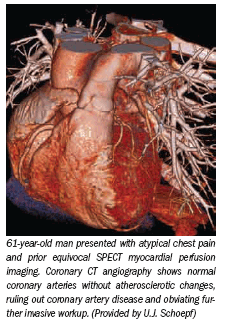South Carolina radiologist stands against 'Rad Scare'
Radiologists were urged at the RSNA meeting to combat distortedreports about cardiac CT radiation exposure that raiseunreasonable public anxiety about the risk of medical imaging.
Radiologists were urged at the RSNA meeting to combat distorted reports about cardiac CT radiation exposure that raise unreasonable public anxiety about the risk of medical imaging.
Dr. Joseph Schoepf, a professor of radiology at the Medical University of South Carolina in Charleston, addressed the public perception of CT and cancer risks during a cardiac imaging session.
"We cannot allow and we cannot afford a public discussion of what we do to be all of a sudden overtaken by radiation fear, considering all the benefits that we provide our patients on a daily basis," he said.
Schoepf criticized mainstream media reports of a study published last year in the Journal of the American Medical Association that deals specifically with coronary CT angiography (2007;298[3]: 317-323). The paper concluded that patients undergoing cardiac CT had a one in 114 risk of developing cancer.
"We looked at that study, its overall conduct and design, and found no fault in it," Schoepf said. "If we did the same analysis, we would probably have come to very similar results and conclusions."

However, the lay press stirred public concern with that study's statistics but overlooked that the figure was calculated using data extrapolated from Hiroshima and Nagasaki atomic bomb survivors.
The press also neglected to mention that the theoretical-no patients were actually scanned-cardiac CTA protocol included a 20-year-old woman scanned with a high dose, he said.
Schoepf also challenged an editorial by Drs. Rita F. Redberg and Judith Walsh accompanying a study on cardiac CT published Nov. 27 in The New England Journal of Medicine. Their critique quoted evidence that cardiac imaging leads to unnecessary procedures and "bombards patients with radiation many orders of magnitude greater than that of traditional radiographs."
To counter such claims, Schoepf presented results of a study led by MUSC physicist Walter Huda, Ph.D., that calculated radiation risks of 104 patients with a median age of 59 who underwent cardiac CT on a 64-slice scanner. They found the average patient's risk of developing cancer was 0.12%, with a mortality risk of 0.1%, mostly from lung disease.
Schoepf moved to allay fears by pointing out that no data directly link CT-based radiation with cancer. He also noted that his group's study followed a design similar to that of the JAMA paper by using the Biological Effect of Ionizing Radiation (BEIR) VII Phase 2 method to calculate fatal and nonfatal radiation-induced cancer risk but applied the calculations to an actual clinical population. These calculations are filled with uncertainties, however, and physicians know that cardiovascular and coronary artery disease is a greater killer than cancer, Schoepf said.
What New Lung MRI Research Reveals About Post-COVID-19 Conditions in Children and Adolescents
February 25th 2025Adolescents with post-COVID-19 conditions had 37 percent lower quantified lung perfusion than healthy control participants on phase-resolved functional lung MRI, according to findings from a recent prospective study.